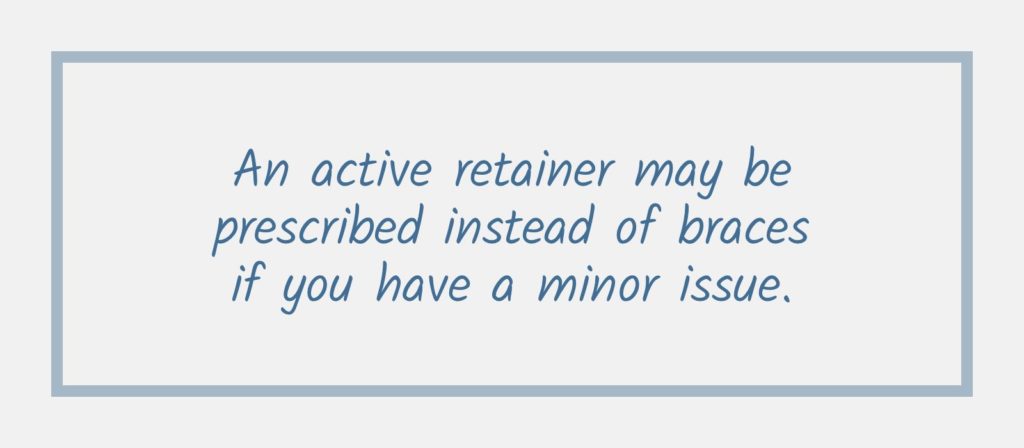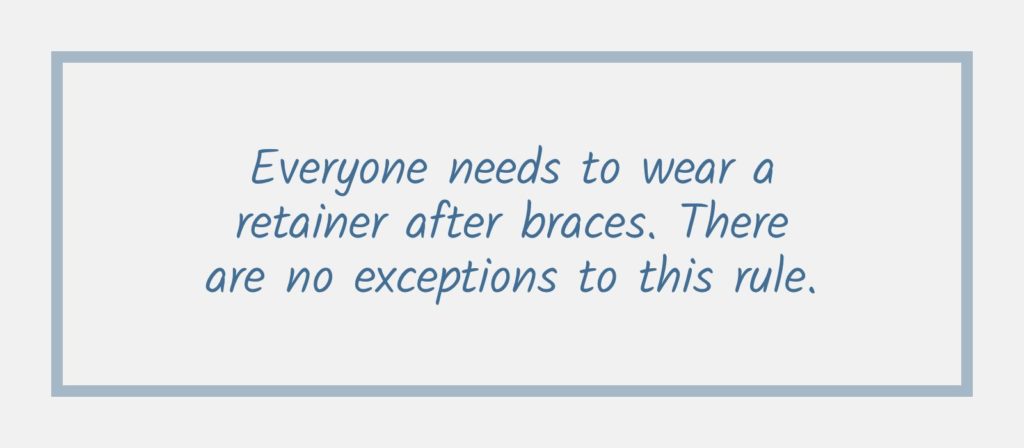How Long Should I Wear My Retainer?
Often people ask us how long they need to wear their retainer after having orthodontic treatment. There are many factors that may influence how long someone needs to wear their retainer, but the best recommendation we can give you is to wear your retainers for as long as you want for your teeth to stay straight! Simply, the longer you wear the retainer, the longer your teeth will remain in their desired position since teeth can shift without regular wear of a retainer.
THE PURPOSE OF RETAINERS
Regardless of whether you had traditional braces or Invisalign treatment, you will still need to wear a retainer in order to maintain the results achieved through orthodontic treatment. Without consistent wear for the rest of your life, you unfortunately risk the chance of your teeth returning to their pre-orthodontic position.

Text: Did you know that the Hawley retainer is the most popular type of retainer? It features a metal wire that surrounds the six anterior teeth and holds them in place.
A simple way of understanding why this happens is to think of your teeth as having a memory of their own. Typically, it takes about a year for teeth to become stable in a new position. During this time period, your teeth are especially likely to want to shift back to their old position because bone has not yet fully formed around their new position to keep them stable. A retainer helps train your teeth to stay in their new ideal position while this process takes place.
TIMELINE OF RETAINERS
For the first 3-6 months of being braces free, you should aim to wear your retainers 22 hours/day or otherwise instructed by your orthodontist. When your orthodontist feels confident that you are achieving some stability, they will allow you to transition to nighttime only wear. You should continue wearing your retainer every night until you have been in retainers for about a year. After a year has passed, you should be okay to wear your retainer every other night for the rest of your life.
If you ever feel that your retainer feels tight, you should resume wearing it every night until the retainer slightly loosens into a more comfortable position. As you age, your teeth will begin to naturally shift forward. This process doesn’t happen instantly, but over time it can have a noticeable effect on your smile. Wearing your retainers regularly will help prevent this from happening.
TYPES OF RETAINERS
There are three main types of retainers that your orthodontist may have you wear. It’s important to understand that none of these retainers are made to last a lifetime. With regular wear, they will slowly become less effective. So in order to wear retainers and preserve your straight smile for the rest of your life you will need to have them replaced periodically.
Bonded (Permanent) Retainers:
Bonded retainers are made by forming a wire along the back of your teeth and securing it so that it holds your teeth in their desired position. Bonded retainers can be made for both the upper and lower teeth but may not be recommended for both depending on your bite. These retainers generally require more daily maintenance and need to be both flossed nightly and brushed around daily. Ask your orthodontist or dental hygienist for “flossers” that help make it simpler to floss a permanent retainer. Bonded retainers can last anywhere from 2-5 years depending on how well they are taken care of.

Text: An active retainer may be prescribed instead of braces if you have a minor issue.
Hawley Retainers:
Hawley retainers are probably the most well-known type of retainers. They have a metal wire that wraps around a series of 6 teeth in order to keep them held securely in place. They are often recommended for both the upper and lower teeth. Unlike bonded retainers, Hawley retainers can be more easily adjusted but will still wear out over time and need to be replaced every 5-8 years.
Essix Retainers:
Essix retainers are clear snap on retainers that fit over your teeth. These retainers need to be cleaned very well after each use but eventually the plastic will wear out and may even crack. Typically, Essix retainers last 1-3 years.
Regardless of the type of retainer that you have, you should always be on the lookout for signs of wear and tear. If your retainer begins to lose its shape so that it can no longer effectively retain your teeth or you notice waking up without it in the morning you should immediately call your orthodontist for an adjustment. Make a habit of inspecting your retainer regularly for cracking, bending, or loosening.
RETAINER MAINTENANCE
It’s important to take care of your retainer as instructed by your orthodontist. Proper care will help preserve the condition of your appliance and will help it last as long as possible. We always recommend that you bring your retainer with you to your 6-month hygiene visits so that we can inspect and clean the retainer for you.
Additionally, you should be cleaning your retainer regularly at-home. This can be as easy as brushing it nightly with a soft-bristled toothbrush and lukewarm water to remove any hardened plaque or debris on the retainer. Some retainer cleaners may be advised depending on what type of retainer you may have. It is recommended that you speak with your dentist or orthodontist to see which type of cleaning product is best for your retainer.
Contact Us:
With the New Year approaching, it is important to look on the bright side if you’re wearing retainers! Even though wearing your retainer for the rest of your life may seem like a big commitment, this is a much easier solution that having to undergo orthodontic treatment all over again.
If while wearing your retainer and anything feels uncomfortable, we advise you to please contact River Run Dental for an adjustment! We would be more than happy to help you with making your retainer much more comfortable so that you can wear it regularly.

Text: Everyone needs to wear a retainer after braces. There are no exceptions to this rule.

